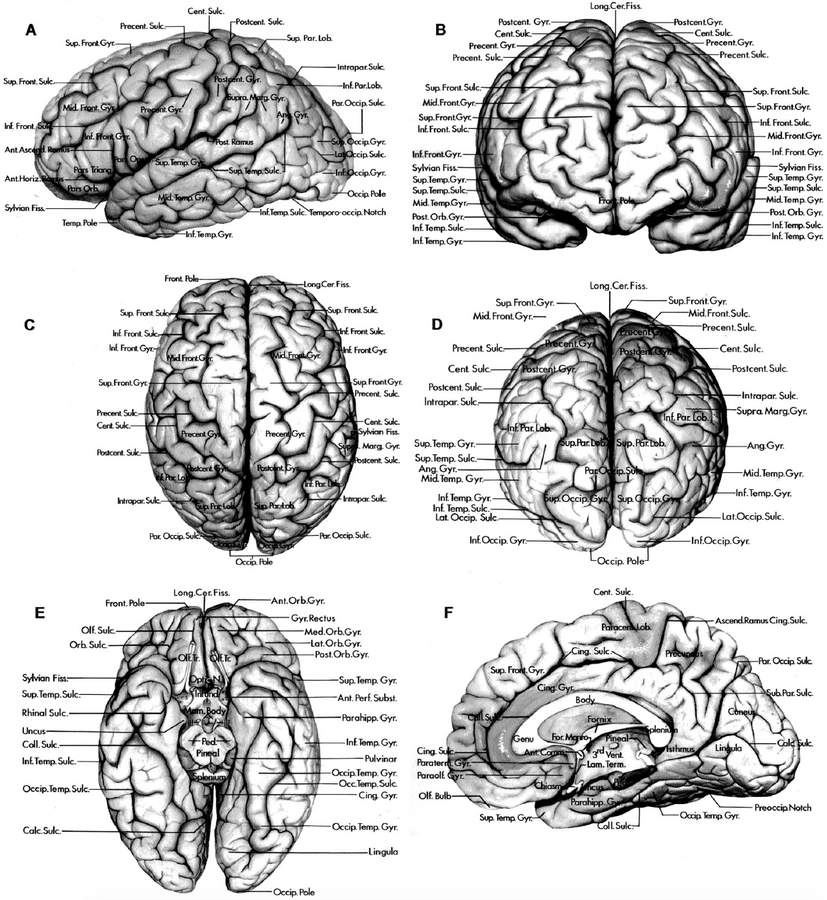Lateral, Medial, and Inferior Surfaces of the Cerebral Hemispheres
5595
Surgical Correlation
Tags
A–D, lateral surface (A, lateral view; B, anterior view; C, superior view; D, posterior view). E, inferior surface. F, medial surface. A–F, the longitudinal cerebral fissure separates the cerebral hemispheres. The lateral surface of the frontal lobe extends from the frontal pole to the central sulcus and is demarcated inferiorly by the sylvian fissure. The precentral gyrus is situated between the central and pre-central sulcus. The superior and inferior frontal sulci divide the part of the lateral surface in front of the precentral gyrus into the superior, middle, and inferior frontal gyri. The inferior frontal gyrus is divided by the anterior horizontal and the anterior ascending rami of the sylvian fissure into the pars orbitalis, pars tri-angularis, and pars opercularis. The parietal lobe is demarcated anteriorly by the central sulcus and posteriorly by a line extending from the superior limit of the parieto-occipital sulcus to the preoccipital notch. The anterior part of the parietal lobe is formed by the postcentral gyrus, which is situated between the central and postcentral sulci. The area behind the postcentral sulcus is divided by the intraparietal sulcus into the superior and inferior parietal lobules. The inferior parietal lobule includes the supramarginal gyrus, which surrounds the upturned end of the posterior ramus of the sylvian fissure, and the angular gyrus, which surrounds the upturned posterior end of the superior temporal sulcus. The lateral occipital sulcus divides the lateral aspect of the occipital lobe into the superior and inferior occipital gyri. The lateral surface of the temporal lobe behind the temporal pole is divided into the superior, middle, and inferior temporal gyri by the superior and inferior temporal sulci. The inferior surface of the frontal lobe is formed by the gyrus rectus and the orbital gyri. The olfactory tract courses in the olfactory sulcus, which separates the gyrus rectus from the orbital gyri. The orbital sulci divide the orbital surface of the frontal lobe into the anterior, medial, lateral, and posterior orbital gyri. The inferior surface of the temporal lobe, proceeding from medial to lateral, is formed by the parahippocampal, occipitotemporal, and inferior temporal gyri. The occipi-totemporal sulcus separates the occipitotemporal and inferior temporal gyri. The collateral and rhinal sulci separate the parahippocampal and occipitotemporal gyri. A narrow strip of cortex at the posterior end of the parahippocampal gyrus, called the isthmus of the cingulate gyrus, wraps around the splenium of the corpus callosum and connects the posterior ends of the parahippocampal and cingulate gyri. On the medial surface of the hemisphere, the callosal sulcus separates the corpus callosum from the cingulate gyrus. The cingulate sulcus separates the cingulate gyrus from the superior frontal gyrus. The ascending ramus of the cingulate sulcus ascends along the posterior margin of the paracentral lobule. The subparietal sulcus separates the precuneus and the cingulate gyrus. The parieto-occipital sulcus separates the precuneus and the cuneus. The calcarine sulcus extends forward from the occipital pole and divides the medial surface of the occipital lobe between the cuneus and lingula. The paraterminal and paraolfactory gyri are situated below the corpus callosum in front of the lamina terminalis and anterior commissure. The inferior surface of the occipital lobe is formed by the lower part of the lingula and inferior occipital gyrus and the posterior part of the occipito-temporal gyrus. The mamillary bodies and infundibulum are in the floor of the third ventricle below the foramen of Monro. The oculomotor nerves arise on the medial surface of the cerebral peduncles. The optic nerves are situated at the medial ends of the sylvian fissures. (Images courtesy of AL Rhoton, Jr.)




